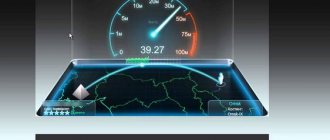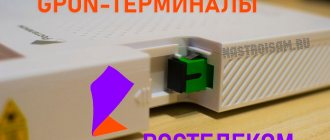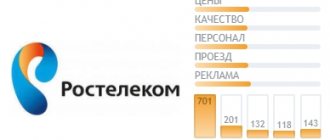It is difficult to imagine the life of a modern person without the Internet, and over the years, consumers of telecommunication services want to have a better high-speed connection. The West was the first to think about how to offer the population truly high-quality Internet that can satisfy even the most demanding customers. While many in Russia still had a vague idea of what the “World Wide Web” was, in England they were already talking about gigabit PON technology, or passive optical networks. In the Russian Federation, Rostelecom began implementing GPON, being the first to propose connecting three services at once using this innovative technology - Internet, interactive television and telephone.
About optics and PON
If there was something unclear to you from the definition, now I will try to explain this concept in more detail. At the moment, optical cables are laid everywhere in cities - that is, the optics go all the way to the house, connect to a special modem-switch, and then apartments are connected using twisted pair cables.
Optical cable
Optics are special glass cables through which information is transmitted using light. Due to this, information can be transmitted over many kilometers. Via twisted pair cable you can transmit data over a maximum distance of 50-100 meters. That is why this technology is called a passive optical network - because we can throw wires without the use of repeaters and other devices.
twisted pair
Well, the technology itself involves laying an optical cable directly to the subscriber’s apartment. That is, we have two types of connection from Rostelecom:
- The usual thing is that the optics go to the house, then connect to the switch, and apartments are connected from it using a twisted pair cable.
- xPON – optics are directly connected to the subscriber’s apartment.
Why do we need PON technology at all ? Firstly, it is cheaper for Rostelecom itself, because there is no need to install equipment on each floor. Secondly, there is almost no packet loss with such a connection, since light (in optics), unlike electricity (in twisted pair), has almost no influence from electromagnetic waves. As a result: there is less ping in games, the speed does not jump or drop, and the Internet is much more stable. Thirdly, the speed increases significantly and you can connect to the Internet at speeds of 300, 500 or even 1 Gbit per second.
Let me remind you that Rostelecom uses GPON technology - the letter “G” stands for “Gigabit” - this means that the speed can be higher than 1 Gbit per second.
I advise you to read more about twisted pair and optical cable.
Rostelecom Game RT-X gaming terminal
At the time of writing, this is the most technically advanced, most expensive (almost 9,000 rubles) and most interesting GPON terminal from Rostelecom. The RT-X model is presented as a gaming optical router specifically for gamers using artificial intelligence technologies, separate traffic prioritization and reducing the time of data exchange with remote servers. It is stated that there is a neural network module that recognizes game traffic and increases its priority over other data.
Judging by the fact that the Game RT-X router is presented as a joint development by Rostelecom and Huawei, in which specialists from both companies participated, the device does not have a direct prototype among existing models. Perhaps something was taken precisely from the Huawei Echolife K5 Pro mentioned above, but these are not just assumptions.
Specifications: Chip – SD5117V ROM – 256 MB RAM – 128 MB WiFi 2.4 GHz – SD1151 V742 chip WiFi 5 GHz – SD1151 V740 chip Ports: 1 x GPON type SC/APC 4 x Gigabit Ethernet 100/1000Base-T 2 x POTS FXS RJ-11 1 X USB 2.0
Game RT-X firmware:
Standard IP address: 192.168.0.1 Authorization: login - admin, password - unique, on a sticker
Connection diagrams
Rostelecom has several home connection schemes:
- FTTN – optics extend from the network node of a district or an entire city.
- FTTC - optics extends only from a small microdistrict.
- FTTB – optics are connected to the building.
- FTTH - optics are extended to the entrance or apartment, as in our case.
Read more about connection types here.
Fiber Optic Equipment
To convert the signal into an understandable Ethernet interface, another unique device is used - ONT, or optical terminal. Devices of this type are presented in a wide range, and it can be either a standard device with two Ethernet ports and one PON port, or a full-fledged Rostelecom GPON router, which has a number of advantages in the form of:
- four gigabit Ethernet ports;
Important! Ports zero and one are used exclusively for connecting high-speed Internet, and ports 3 and 4 are used for viewing IP television.
- There are two connectors for IP telephony;
- it is possible to connect interactive IPTV;
- GPON signal distribution from Rostelecom is carried out via Wi-Fi (802.11n standard with a throughput of up to 300 megabits per second).
Users of the World Wide Web will no longer be surprised by a speed of 100 Mbit/second. Using Rostelecom's GPON equipment, Internet capabilities will soon be limited to gigabytes of information received per second. Only an optical cable can support such high speeds, especially when it comes to long distances of information transmission. Moreover, Rostelecom optics enter the apartment not through a copper cable, as is the case with the FTTH bandwidth, but by dividing the signal using a special optical splitter. After installing the modem, however, you will encounter the problem of setting it up. This is not difficult to do using our tips.
How to connect?
In general, I’ll tell you my story that happened to me. I live in the private sector and then there was a rumor that Rostelecom was installing fiber optics. I called, clarified and left a request for an Internet connection and IP-TV. If you live in an apartment, you can also call and find out if you can connect using GPON technology. If possible, then connect. If not, then there may be two options:
- You can stay on twisted pair - in fact, you are already connected to optics, it’s just the “vikha” that goes to the apartment. There is nothing wrong with this, as experts say, there are no serious packet losses, but there will be no speed above 1 Gbit.
- Get together the residents of the building and write a collective application for the provision of optics to each apartment. Of course you will have to pay for this.
In any case, just call the Rostelecom hotline, and they will tell you everything: 8 (800) 10-00-800 - also don’t forget to ask about the “GiPON” tariffs that they have.
Which modems are suitable for connecting PON from Rostelecom
GPON technology is an industry-wide interchangeable standard. This indicates that PON modems from any manufacturer will work correctly with devices such as ONT.
This, in turn, reduces the cost of equipment and enables providers to offer subscribers the most favorable tariffs for services. It is also important to note that the updated technology based on XGPON standards increases network performance up to 10 Gbit, while maintaining backward compatibility with already deployed networks.
What to do after application?
Once you have the optics installed, you will also have two connection options, but first things first. Let's start with the fact that the computer does not understand the information that is transmitted via an optical cable. This is understandable: it doesn’t even have such a port. Therefore, to connect you need:
- A regular GPON terminal - it will essentially act as a kind of translator and bridge. The input will be optical and the output will be Ethernet. Then the terminal itself can be connected to the computer directly or using a router so that all family members can enjoy the benefits of the Internet.
- A fiber optic GPON router is two in one: both a terminal and a router.
And now the most important thing - they will sell you SFP routers or terminals from Rostelecom, they will say that they only work with their equipment. Know that they just want to make money from you, since such terminals and routers cost many times more than their competitors. I advise you to simply buy a router with an SFP port or a similar terminal. In general, there is only one piece of advice - don’t buy or rent anything from them. See a selection of routers with optical cables here.
Description of GPON technology
After talking with neighbors and acquaintances who appreciated the quality of GPON technology from Rostelecom, many have no idea what they will have to deal with. Therefore, we will briefly explain what this technology is and what advantages it has. First of all, we note that this technology is passive, and in this case this means that there is no additional active equipment along the route of the optical Internet line from the service provider to the client.
It is impossible, of course, to say that there are no barriers at all, since direct laying of an expensive cable is very expensive, it’s just that in some places the signal is divided. For this, a special device is used - a splitter, or optical divider, which divides Rostelecom's optical fiber into several lines. The question remains unclear how such a long-awaited Internet will reach the end consumer, and what equipment is used for this.
Setting up GPON equipment Rostelecom
Everything is done very simply - so there is no need to be afraid. If you bought a router yourself, then you can see detailed instructions on setting up the equipment on our website. You can ask a question in the comments or find the instructions yourself - to do this, enter the full name of the model into the search bar on the portal.
If you purchased a device from Rostelecom, then most likely you have an ONT NTP-RG-1402G-W router . You can watch the video below for setup. If you have a different device, write in the comments, and I will add instructions for it - just please write the full name of the model, which can be seen on the label under the case.
GPON Internet tariffs
Prices are different for each region!
For many users, the issue of the cost of telecommunications services is far from idle, and in this regard, fiber optic tariffs from Rostelecom can be called “democratic”, given the range of services offered. The user, by the way, can choose the service himself: home Internet, television, landline or mobile phone, terminal rental, while you can order a separate service, or you can combine packages. The tariffs, in fact, depend on the range of offers, and, according to user reviews, they are affordable today. It is also worth remembering that prices for each region may differ, and on the official RTK website you can always find out about promotions and advantageous offers.
How to connect a wireless Wi-Fi connection on a computer with Windows 7
The procedure for connecting a wireless Internet connection from Rostelecom:
- find the Internet icon in the lower right part of the screen, click on it;
- select a wireless network;
- password is entered;
- After entering the password, the connection is established.
Important! During connection, it is recommended to check the “Connect automatically” checkbox. Thanks to this, the connection will be established automatically when you turn on or the computer comes within range of the network.
How to connect multiple devices to the network
It is known that often for the Internet at home, and even more so in an organization, it is necessary to connect several devices to the network. In this case, a modem with one connector is not enough. In this case, you need an additional device - a router.
The task of the router is to distribute the network connection to several devices using LAN connectors. Its configuration occurs through the web interface in the browser, or using special software (depending on the model).
How much does it cost to connect a private house?
When technology has already arrived in your sector or village, connection may not cost anything at all, as happens in apartment buildings.
However, due to the specifics of home ownership, prices for extending optical fiber even just from a Rostelecom “pole” on which a distribution terminal is hung can start from 5-6 thousand rubles. Even if the distance from the pole to your house is less than 30-100 meters. According to reviews from subscribers who provided similar services, the price tag can be 5, 13, or even 20 thousand for one household. Lately, however, it has been trending downward, since Rostelecom is actively expanding its network to the most “hard-to-reach” settlements using cheap PON technology, and people are willing to connect (there is demand).
In the future, the subscriber simply pays a monthly fee for the tariff in standard mode, as in an apartment. There may (but usually is not) an additional network service charge.
If the Internet needs to be “pulled” into the village and it is not yet connected, the price tag increases, sometimes many times over. Even 10 kilometers of such a connection can cost a company more than 200-300 thousand, and not every subscriber will agree to “share this burden.” You just have to wait until technology itself knocks on the door.
When connecting ADSL, the cost is, of course, lower, because the company does not have to lay anything additional, everything is connected to an existing telephone line. Here the price can be from 500-1000 rubles and above. Sometimes it's free.
Connecting a 4G modem is the simplest, but you will have to spend money on the modem itself and, possibly, a router with the ability to connect such equipment. There is no one-time payment for a SIM card.
Mobile Internet
When it is impossible to connect to fiber optic and there is no landline connection, the client thinks about how to connect the Internet in a private home without a telephone and an optical router. The 3G connection that appeared in Rostelecom comes to the rescue.
3G communication is relevant for those who do not use computers or laptops to access the network, but choose smartphones and tablets. The advantage of wireless Internet is the ability to use it anywhere: in the park, in the country, in a cafe.
- For your information
- The speed of such communication is maximum, and the volume of traffic depends on the tariff chosen by the subscriber.
Pros and cons of networks based on XPON in Rostelecom
The main advantage of networks with fiber optic cable is undoubtedly speed. Research in recent years has shown that this cable will be the basis of urban wired Internet networks in the future. In one of the experiments in the USA, it was possible to establish a speed of 159 terabits per second over a distance of more than 1,000 km.
Let's consider other positive aspects of this type of cable used in Rostelecom:
- A significant advantage of the cable is its support for various types of transmitted data, which makes it possible to make calls and watch TV on devices that access the Internet;
- This cable consists of fiberglass fibers. This means that they do not require electrical current to transmit data. And this leads to a reduction in the costs of their maintenance and operation; Fibers in xPON cable
- Due to the fact that the cable uses light to transmit information, another positive point in comparison follows - the signal does not depend on voltage drops.
Let's look at a few disadvantages of XPON technology:
- The fibers should not be subjected to sharp bending during installation; Installation of cable for Internet connection
- Traffic encoding systems are required due to the vulnerability of networks;
- Problems with eliminating vulnerabilities at the physical level.
In general, many of the disadvantages of these cables also apply to copper cables. And we can talk about this topic for quite a long time.
How to enter network settings for Windows 7
If there is a need to manually enter Rostelecom connection parameters, configure the IP address, network mask, default gateway and DNS server on Windows 7, then you need to use the control panel.
- You need to go to the main menu, select “network and Internet”;
- then “change adapter settings”;
- select the desired item (wireless network or Internet), right-click, find the IPv4 item, this is where all the necessary parameters are present.
Optics for the home - what does it all look like?
Now I will show how xPON home optics from Rostelecom looks from the technical side - from the beginning, that is, from the station, to the very end subscriber Internet access device.
The station part is the OLT terminal . It is the starting point of the optical signal to the client. These terminals differ in the number of ports.
One port can usually connect up to 128 subscriber devices. The xPON coverage area is built in clusters and, depending on the scale of the construction and taking into account further expansion, the corresponding head unit is installed.
Next come passive splitters - optical “dividers”. They are placed in places where the optical cable branches in the line. In its simplest form, the splitter looks like this:
Usually the network is built in such a way that there are 2 splitters on the line from the station to the subscriber. The first splitter is located in the distribution cabinet and the cable areas are connected from it. The second is the so-called drop coupling, from which the cable already goes to the subscriber. In multi-storey buildings it looks like this:
In the private sector, drop couplings are hung on poles and they look like a medium-sized plastic box with black wires going into it:
It is from here that the drop cable stretches directly to the subscriber where the optical socket is already installed. An optical cord (OSC) is laid from the socket to the terminal access device.
Cords for xPON are yellow with an SC connector at the ends. Pay attention to the connectors themselves, they are used in blue or green:
It would seem, what's the difference? And the difference is in the tip of the connector - it is called “ferula”. Upon closer inspection, everything immediately becomes noticeable.
By the way, if you look at the optical terminal, its socket color will match the color of the connector.
The last link in the chain is the subscriber ONT terminal - an access device installed on the client side. From the front it looks like a regular WiFi router.
But on the back, the optical input that serves as a WAN port immediately catches your eye. I will tell you more about which PON terminals are used in Rostelecom below.
And one more small note for future subscribers. Please note that optical fiber does not curl and can be broken. If you somehow damage or tear it, it will be impossible to connect without special equipment. Welding and repairing such a cable is carried out using a welding machine.
To measure line parameters and search for breaks, specialized expensive equipment is also used - an optical reflectometer. Based on the data obtained after measurements, the device generates a list of characteristics, which is called a reflectogram.
By the way, damage can often be detected without a reflectometer, simply by walking along the patch cord from the router to the outlet. Optics really don’t like bends, and users quite often manage to bend the cable at different sharp angles, and this is the first reason why the LOS light on the terminal is on.











